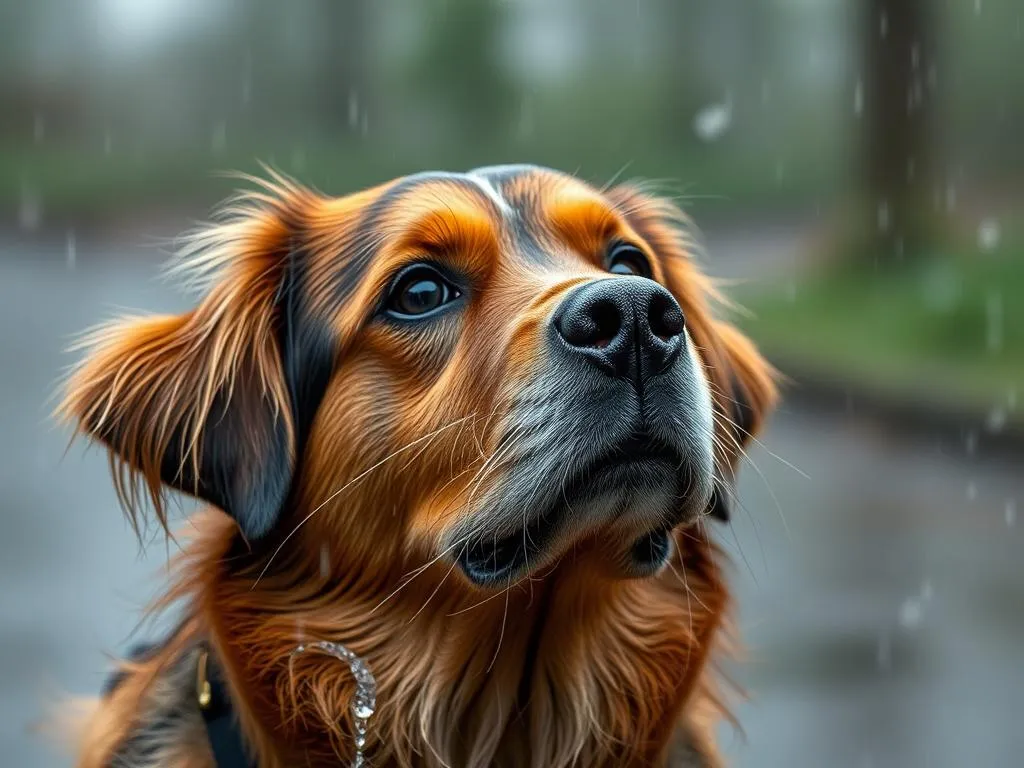
Introduction
As a dog owner, you may have experienced the puzzling behavior of your furry friend when faced with rain. Many dogs refuse to pee in the rain, leaving their owners frustrated and worried. Understanding this behavior is crucial for maintaining your dog’s health and comfort. In this article, we’ll explore the reasons behind why dogs might hesitate to relieve themselves in wet weather and provide actionable strategies to encourage them to go outside, even in the rain.
Understanding Dog Behavior
The Nature of Dogs
To comprehend why your dog won’t pee in the rain, it’s essential to appreciate their instincts. Dogs are creatures of habit and are significantly influenced by their environment. They rely on their senses—sight, smell, and touch—to navigate their surroundings. When confronted with rain, the sensory experience changes dramatically. The sound of raindrops, the smell of wet ground, and the sensation of wet fur can all be overwhelming for some dogs.
Common Reasons Dogs Avoid Peeing in Rain
There are several reasons your dog might be avoiding urination during rainy weather:
-
Sensitivity to Weather Conditions: Some dogs are particularly sensitive to changes in weather. The sound of rain can be startling, and the sensation of getting wet may be uncomfortable for them.
-
Discomfort with Wet Surfaces: Many dogs dislike the feeling of wet grass or pavement. Their instinct may drive them to seek out dry ground, leading to reluctance in urinating when the ground is soggy.
-
Fear or Anxiety Related to Rain or Thunder: Dogs that have had negative experiences with rain or thunderstorms may develop a fear of these conditions. This anxiety can manifest as an unwillingness to go outside, which includes avoiding urination.
Health Implications of Avoiding Urination
Risks of Holding Urine
When dogs refuse to relieve themselves in the rain, they may hold their urine for extended periods. This behavior can lead to several health concerns:
-
Urinary Tract Infections (UTIs): Holding urine can create a breeding ground for bacteria, increasing the risk of UTIs.
-
Bladder Problems: Chronic retention can lead to bladder distension and, in severe cases, bladder stones or rupture.
-
Overall Health Concerns: Regular urination is essential for flushing out toxins. A dog that avoids urination may face additional health issues over time.
Signs Your Dog May Have Health Issues
To ensure your dog’s health, keep an eye out for:
- Changes in urination habits, such as frequency and volume.
- Other signs of distress, such as whining, pacing, or hiding when it’s raining.
If you notice any concerning changes, it may be time to consult a veterinarian.
Strategies to Encourage Your Dog to Pee in the Rain
Pre-Rain Preparations
Building a positive association with rain can help. Before rainy days:
-
Introduce Your Dog to Rain: Let your dog experience light rain in a controlled environment. Gradually expose them to heavier rain while providing treats and praise.
-
Training Techniques: Use commands like “go potty” consistently during dry weather. When they successfully relieve themselves, reward them immediately to reinforce the behavior.
Equipment and Accessories
Investing in the right gear can make a difference:
-
Raincoats and Boots: A waterproof coat can help keep your dog dry and comfortable. Dog boots can protect their paws from cold, wet surfaces, making them more willing to go outside.
-
Choosing the Right Outdoor Spaces: Find areas with adequate shelter, such as awnings or trees, where your dog can relieve themselves while staying dry.
Timing and Routine Adjustments
Adjusting your routine can help mitigate the challenges of rainy weather:
-
Scheduling Potty Breaks: Keep an eye on weather forecasts and schedule potty breaks during lighter rain or breaks in the weather.
-
Creating a Consistent Routine: Dogs thrive on routine. Establish a consistent schedule for potty breaks to reduce anxiety and encourage them to go outside.
Behavioral Training Techniques
Positive Reinforcement
Using positive reinforcement effectively can encourage your dog to pee in the rain:
-
Using Treats and Praise: When your dog successfully pees outside, reward them immediately with treats and praise. This helps them associate outdoor urination with positive experiences.
-
Timing of Rewards: Ensure rewards are given right after they pee, so they connect the action with the reward.
Desensitization Techniques
Gradual exposure can help desensitize your dog to rain:
-
Controlled Environments: Start with light rain or use a spray bottle to mimic the sensation of rain in a controlled setting. Reward them for staying calm and eventually for peeing.
-
Positive Experiences: Make outdoor time enjoyable by playing with toys or engaging in activities they love, associating these with rainy weather.
Working with a Professional Trainer
If you’re struggling, consider seeking professional help:
-
When to Seek Professional Help: If your dog’s fear of rain is severe, a professional trainer can provide tailored strategies to address their specific needs.
-
Benefits of Tailored Training Plans: A professional can offer insights based on behavioral science, helping your dog overcome their fear and develop healthier habits.
Understanding Your Dog’s Preferences
Individual Differences Among Dogs
Each dog is unique. Factors that influence their behavior include:
-
Various Breeds and Their Sensitivity to Weather: Some breeds are more tolerant of wet conditions than others. Research your dog’s breed traits to better understand their preferences.
-
Age-Related Factors Influencing Behavior: Older dogs may be less tolerant of harsh weather, while puppies might be more curious. Tailor your approach based on your dog’s age and personality.
Observing Your Dog’s Body Language
Understanding your dog’s body language can provide insight into their feelings:
-
Signs of Discomfort or Anxiety: Look for signs like trembling, whining, or attempting to hide. Addressing these feelings can help alleviate their reluctance to go outside.
-
Understanding Your Dog’s Unique Reactions: Every dog reacts differently to rain. Pay attention to their cues and adjust your approach accordingly.
Alternative Solutions for Rainy Days
Indoor Potty Solutions
When outdoor conditions are unfavorable, consider indoor options:
-
Overview of Indoor Potty Options: Potty pads, artificial grass patches, or designated indoor potty areas can provide alternatives when it’s too rainy to go outside.
-
Benefits and Drawbacks of Indoor Alternatives: While these solutions can help avoid accidents indoors, they may not be ideal for all dogs. Some may still prefer outdoor relief, while others might adapt quickly.
Maintaining a Healthy Urinary Routine Indoors
Even with indoor solutions, maintaining a healthy routine is essential:
-
Regular Bathroom Breaks: Ensure your dog has regular opportunities to relieve themselves, whether indoors or outside.
-
Keeping Track of Your Dog’s Urination Schedule: Monitor how often your dog is urinating to ensure they are maintaining a healthy routine, regardless of their location.
Conclusion
Understanding why your dog won’t pee in the rain is vital for their health and well-being. By recognizing their unique behaviors, addressing any health implications, and employing effective strategies, you can help your dog feel more comfortable in wet weather. Patience and understanding are key as you support your furry friend in overcoming their reluctance to relieve themselves outside during rainy days. Remember, maintaining your dog’s health is a multifaceted approach that includes their environment, behavior, and emotional well-being.









